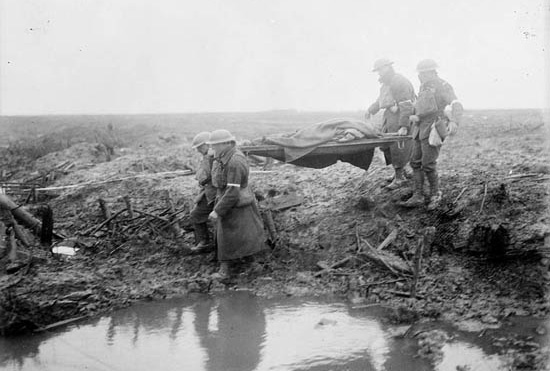Stray shells
First World War Audio Archive
Stray shells
Transcript
Hill 62 Memorial Belgium.
Passchendaele, but I went in at the second of September at the Drocourt-Queant switch. That was a, that was a time. And that’sCourtrai Memorial Belgium.
when Fritzy counter-attacked on us, drove us back and the only time that I can, that I know of where there was a bayonet attack.Le Quesnel Memorial Belgium.
I didn’t use a bayonet because I was a machine gunner. I had a machine gun crew. I was in charge of a machine gun crew, but theGueudecourt Memorial France.
rifle men put the bayonets on and they went over there and hand to hand fighting with the Germans, and we were just strafing theDury Memorial France.
ground ahead of them, keeping the other fellows down, making them stay down. And then he counter-attacked and chased us back and weMonchy Memorial France.
stayed there until the morning of the third of September and by that time he had evacuated and we walked out. Anyway, that was the end it. And there was a stray shell came out from somewhere or another on the morning of the third of September, hit me onPasschendaele Memorial Belgium.
the leg and, I thought, and cut my gas mask off. I went back to find a gas mask off of a casualty and was going to go back up toMasnières memorial France.
the front line and I met a stretcher bearer by the name of Scotty Deans and Scotty said to me, “You’re wounded!” I said,Bourion Wood Memorial France.
"No, I just got a little bit under the chin here,” and he said, “Well, how about your leg, the blood on your leg.” So he took his scissors and he cut a V-shaped piece in my trouser leg and heCourcelette Memorial France.
said, “There is a piece of shrapnel in your left thigh.” And I said, “Scotty, that’s mine, just leave it right there!” And I walked from there and went down to the 4th casualtyBeaumont-Hamel Memorial France.
clearing depot. And down there, there was a doctor who would be in the Medical Officer, 196th Battalion and when he saw me,St. Julien Memorial Belgium.
he said, “You’ve seen enough. I’m going to put a ticket on you and you’re going to Blighty.” And I went to Blighty and by the time I got through my hospitalization and going through theCanadian National Vimy Memorial France.
casualty clearing depot, the Armistice was signed.Description
Mr. Smith describes being in action at Drocourt-Queant (Hindenburg Line), witnessing a bayonet attack, and being wounded again by shrapnel.
Allan A ‘Spike’ Smith
Allan A ‘Spike’ Smith was born in Minto, Manitoba on May 7, 1894. Mr. Smith enlisted while attending the University of Saskatchewan, joining the 196th Battalion. He did his basic training at Camp Hughes, Manitoba. Once overseas, he was at Camp Seaford in England when he was selected to reinforce the 46th Battalion. He saw his first action just prior to Vimy, and was wounded by shrapnel at the Chalk Pits. He returned to action at Drocourt-Queant, and was again wounded by shrapnel. He later returned to Passchendaele. He received a Military Medal for bravery. After the war, Mr. Smith became a farmer, coached a women’s volleyball team, and became an agriculture inspector. He died on August 12, 1981.
Meta Data
- Medium:
- Video
- Owner:
- Veterans Affairs Canada
- Duration:
- 2:26
- Person Interviewed:
- Allan A ‘Spike’ Smith
- War, Conflict or Mission:
- First World War
- Location/Theatre:
- Europe
- Battle/Campaign:
- Drocourt-Queant
- Branch:
- Army
- Units/Ship:
- 196th Battalion
- Rank:
- Lance-Corporal
- Occupation:
- Infantryman
Attestation
Related Videos
- Date modified:




